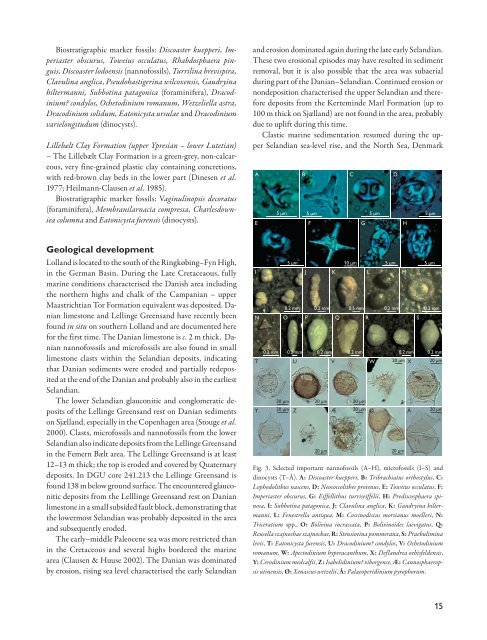Geological Survey of Denmark and Greenland Bulletin 26 ... - Geus
Geological Survey of Denmark and Greenland Bulletin 26 ... - Geus
Geological Survey of Denmark and Greenland Bulletin 26 ... - Geus
You also want an ePaper? Increase the reach of your titles
YUMPU automatically turns print PDFs into web optimized ePapers that Google loves.
Biostratigraphic marker fossils: Discoaster kuepperi, Imperiaster<br />
obscurus, Toweius occulatus, Rhabdosphaera pinguis,<br />
Discoaster lodoensis (nann<strong>of</strong>ossils), Turrilina brevispira,<br />
Clavulina anglica, Pseudohastigerina wilcoxensis, Gaudryina<br />
hiltermanni, Subbotina patagonica (foraminifera), Dracodinium?<br />
condylos, Ochetodinium romanum, Wetzeliella astra,<br />
Dracodinium solidum, Eatonicysta ursulae <strong>and</strong> Dracodinium<br />
varielongitudum (dinocysts).<br />
Lillebælt Clay Formation (upper Ypresian – lower Lutetian)<br />
– The Lillebælt Clay Formation is a green-grey, non-calcareous,<br />
very fine-grained plastic clay containing concretions,<br />
with red-brown clay beds in the lower part (Dinesen et al.<br />
1977; Heilmann-Clausen et al. 1985).<br />
Biostratigraphic marker fossils: Vaginulinopsis decoratus<br />
(foraminifera), Membranilarnacia compressa, Charlesdowniea<br />
columna <strong>and</strong> Eatonicysta furensis (dinocysts).<br />
<strong>and</strong> erosion dominated again during the late early Sel<strong>and</strong>ian.<br />
These two erosional episodes may have resulted in sediment<br />
removal, but it is also possible that the area was subaerial<br />
during part <strong>of</strong> the Danian–Sel<strong>and</strong>ian. Continued erosion or<br />
nondeposition characterised the upper Sel<strong>and</strong>ian <strong>and</strong> therefore<br />
deposits from the Kerteminde Marl Formation (up to<br />
100 m thick on Sjæll<strong>and</strong>) are not found in the area, probably<br />
due to uplift during this time.<br />
Clastic marine sedimentation resumed during the upper<br />
Sel<strong>and</strong>ian sea-level rise, <strong>and</strong> the North Sea, <strong>Denmark</strong><br />
A B C D<br />
5 μm 5 μm<br />
5 μm<br />
E F G H<br />
5 μm<br />
<strong>Geological</strong> development<br />
Loll<strong>and</strong> is located to the south <strong>of</strong> the Ringkøbing–Fyn High,<br />
in the German Basin. During the Late Cretaceaous, fully<br />
marine conditions characterised the Danish area including<br />
the northern highs <strong>and</strong> chalk <strong>of</strong> the Campanian – upper<br />
Maastrichtian Tor Formation equivalent was deposited. Danian<br />
limestone <strong>and</strong> Lellinge Greens<strong>and</strong> have recently been<br />
found in situ on southern Loll<strong>and</strong> <strong>and</strong> are documented here<br />
for the first time. The Danian limestone is c. 2 m thick. Danian<br />
nann<strong>of</strong>osssils <strong>and</strong> micr<strong>of</strong>ossils are also found in small<br />
limestone clasts within the Sel<strong>and</strong>ian deposits, indicating<br />
that Danian sediments were eroded <strong>and</strong> partially redeposited<br />
at the end <strong>of</strong> the Danian <strong>and</strong> probably also in the earliest<br />
Sel<strong>and</strong>ian.<br />
The lower Sel<strong>and</strong>ian glauconitic <strong>and</strong> conglomeratic deposits<br />
<strong>of</strong> the Lellinge Greens<strong>and</strong> rest on Danian sediments<br />
on Sjæll<strong>and</strong>, especially in the Copenhagen area (Stouge et al.<br />
2000). Clasts, micr<strong>of</strong>ossils <strong>and</strong> nann<strong>of</strong>ossils from the lower<br />
Sel<strong>and</strong>ian also indicate deposits from the Lellinge Greens<strong>and</strong><br />
in the Femern Bælt area. The Lellinge Greens<strong>and</strong> is at least<br />
12–13 m thick; the top is eroded <strong>and</strong> covered by Quaternary<br />
deposits. In DGU core 241.213 the Lellinge Greens<strong>and</strong> is<br />
found 138 m below ground surface. The encountered glauconitic<br />
deposits from the Lelllinge Greens<strong>and</strong> rest on Danian<br />
limestone in a small subsided fault block, demonstrating that<br />
the lowermost Sel<strong>and</strong>ian was probably deposited in the area<br />
<strong>and</strong> subsequently eroded.<br />
The early–middle Paleocene sea was more restricted than<br />
in the Cretaceous <strong>and</strong> several highs bordered the marine<br />
area (Clausen & Huuse 2002). The Danian was dominated<br />
by erosion, rising sea level characterised the early Sel<strong>and</strong>ian<br />
5 μm<br />
I J K L M<br />
0.2 mm<br />
N O P Q R S<br />
T U V W 20 μm X<br />
20 μm 20 μm<br />
0.2 mm 0.5 mm<br />
10 μm 5 μm 5 μm<br />
20 μm<br />
Y 20 μm Z Æ 20 μm Ø Å<br />
20 μm 20 μm<br />
0.2 mm 0.2 mm<br />
0.2 mm 0.2 mm 0.2 mm 0.2 mm 0.2 mm 0.2 mm<br />
20 μm<br />
20 μm<br />
Fig. 3. Selected important nann<strong>of</strong>ossils (A–H), micr<strong>of</strong>ossils (I–S) <strong>and</strong><br />
dinocysts (T–Å). A: Discoaster kuepperi, B: Tribrachiatus orthostylus, C:<br />
Lophodolithus nascens, D: Neococcolithes protenus, E: Toweius occulatus, F:<br />
Imperiaster obscurus, G: Eiffellithus turriseiffelii, H: Prediscosphaera spinosa,<br />
I: Subbotina patagonica, J: Clavulina anglica, K: Gaudryina hiltermanni,<br />
L: Fenestrella antiqua, M: Coscinodiscus morsianus moelleri, N:<br />
Triceratium spp., O: Bolivina incrassata, P: Bolivinoides laevigatus, Q:<br />
Reusella szajnochae szajnochae, R: Stensioeina pommerana, S: Praebulimina<br />
levis, T: Eatonicysta furensis, U: Dracodinium? condylos, V: Ochetodinium<br />
romanum, W: Apectodinium hyperacanthum, X: Defl<strong>and</strong>rea oebisfeldensis,<br />
Y: Cerodinium medcalfii, Z: Isabelidinium? viborgense, Æ: Cannosphaeropsis<br />
utinensis, Ø: Xenascus wetzelii, Å: Palaeoperidinium pyrophorum.<br />
15

















